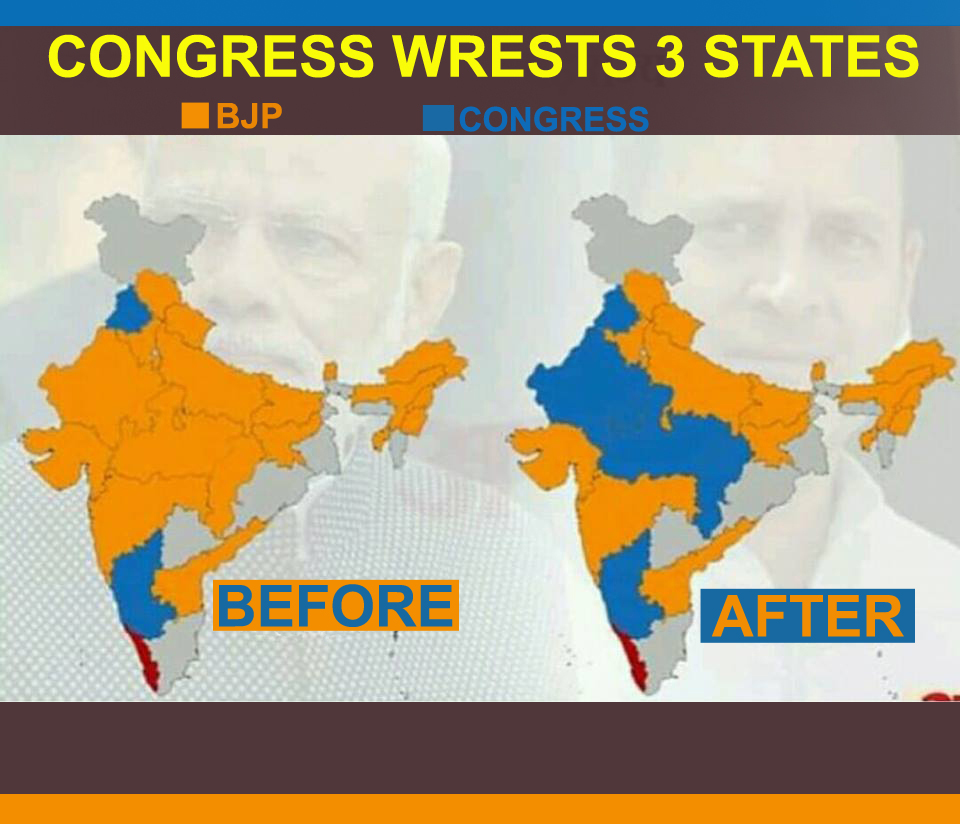These were not just ordinary elections. Nor can the indications be ignored. With about 65 Lok Sabha seats involved in Rajasthan, Madhya Pradesh and Chhattisgarh alone, the points to ponder for the future are many. One of the points is that the Congress had won only three seats from these states in the last elections in 2014. With a few months left for the General (Lok Sabha) Elections, these results show how a pro-rich stance and pro-rich policy formulation mindset does not really go down well with the people of India. This time, the rural disillusionment with the BJP is clearly visible in MP and Chhattisgarh.
Except for Telangana, where there was a complaint that nearly 2.2 million people were left out of the voters’ list, these elections may be considered otherwise clean. Interestingly, there was not much complaint against EVM tinkering, except, again in Telangana. It is a clear message that it is unwise to blame technology if the people manning those machines are purposely fooling around with bad intentions.
While the Congress was swept away in Mizoram, rest of India has not become Congress Mukt (Free of Congress) as the Bharatiya Janata Party (BJP) leaders wanted for themselves. This proves that in spite of a terribly arrogant and corrupt (recent) history of the Congress, people, in a democracy like India, value freedom. Since the BJP preferred to present an autocratic image of itself in the last four-and-a-half years of forming the government at the Centre, that fact hurt its poll fortunes. Also, the strong desire and actions of the BJP to make the nation sort of unitary seems to have negative fallout. It had nothing, at all, to do with anything evenly vaguely close to development (vikas) or eradication of a ‘black’ economy. Demonetisation and GST in quick succession have turned the tables. The poor and rural voter was affected the most due to these decisions.
The only uniqueness that the BJP enjoyed was probably its Hindutva agenda. Religion being everybody’s game, Rahul Gandhi visited temples and performed pooja which could have softened those Hindoos who were fed up with the Congress’ minority appeasement policies of the past. Especially since those very Hindoos expected that since everything was failing, the Modi-led BJP, having a huge mandate in both the 16th Lok Sabha and the Uttar Pradesh Assembly, would at least build the Ram Mandir at Ayodhya for sure. Since that has not happened, the average Hindoo could be deserting the BJP. Sensing this possibility, Hindutva faces of BJP, such as Yogi Adityanath, were thrown in to the campaign trail primarily to offset the anger generated by the torture meted out to scheduled castes and the tribals across the country. The intention might have been to bring about a return of that same chunk of Hindoo voters back into the BJP fold. That obviously does not seem to have worked out. The SCs and STs seem to have moved away from the BJP both in MP and Chhattisgarh. Along with this, however, the disappointment of the Hindoos, too, has not been addressed. It might not be wrong to guess that the Congress lost in both Telangana and Mizoram to strong regional leaderships. Similarly, the BJP could have lost to the Congress in MP, Chhattisgarh and Rajasthan due to a big chunk of traditional Hindutva and trader class voters deserting it. Maybe because of these voters fleeing from the BJP, the Speaker of Lok Sabha, Smt Sumitra Mahajan, herself elected from Indore in Madhya Pradesh, has commented that these results are ‘good for democracy’. Her opinion may not be taken lightly.
There is an angular argument that goes on to say that these results were mark sheets for the local leaders alone and do not, definitely, portend anything ill for Narendra Damodardas Modi’s performance whatsoever. This is a feeble excuse that may not be completely acceptable. No doubt, the anger against the BJP’s local petty leaders must have been high and it may evaporate to a small extent in these states by the time 2019 Elections take place; but let no one forget that the dissatisfaction with the BJP is not due to Raman Singh’s or Shivraj Singh Chouhan’s performance alone. The larger picture painted by that party today does, consciously, play down local leaders as we see in Orissa also. The frame is overcrowded with Modi and Amit Shah. To give a tongue-in-cheek comment, these results may be making the Modi-Shah duo very happy. A strong Shivraj or Vasundhara could have thrown their hat in the ring in 2019 for the topmost position. The duo must have realised, maybe better and before any of us commoners do, that they are in for a bad walloping at the general elections. These results may be indicative that the BJP will not be able to touch the halfway mark at the next LS polls. If that happens, the resentment against Modi-Shah within the BJP would surely surface with vehemence. Resultantly, there could probably be much less space for manoeuvring for the duo if the inner party challenges become strong.
These results have taught a lesson or two to every political party in India. The desire to usurp complete power completely, intolerance of opposition of any hue and the wish to drown out differing voices through trolling will not pay. While the use of social media has been proven to be a loser option, money also has not been the deciding factor. If that would have been the case, certainly the BJP would have been busy choosing its chief ministerial candidates for all these states now. So, it should be believed by all that money, which does play an important role in setting up the logistical support for elections, does not sway votes.
Above all, these results can, safely, be said that true economic growth and non interference in the common man’s life is what the people want. Nothing less, nothing more.
